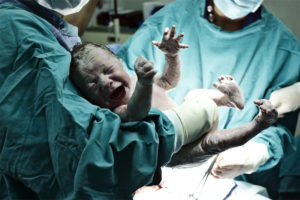Cerebral Palsy Caused by VBAC
Some women who’ve had cesarean births in the past may elect for a vaginal delivery with their next pregnancy. Unfortunately, vaginal birth after a C-section (VBAC) can be risky for these women on account of the complications they and their unborn baby may endure.
While VBAC is not always the safest option when it comes to childbirth, doctors may approve this request as long as certain stringent measures are met. In order to be considered for VBAC, you generally must meet the following conditions:
-

Cerebral Palsy Caused by VBAC
18 to 24 months should have passed since your last cesarean delivery.
- The baby must be a single baby and not twins, triplets, quadruplets and so on.
- You must not have any uterine issues or scars.
- Your transverse incisions must be U-shaped and low.
- You must not have major medical problems such as high blood pressure or diabetes.
- Your baby should not be too large.
- Your baby should be in the correct (non-breech) position.
Risks of a Vaginal Delivery after a Previous Cesarean Section
It’s estimated that anywhere from 60 to 80 percent of all VBAC births are ultimately successful. However, they are not without significant risks. VBAC often leads to uterine rupture, causing oxygen loss or hypoxia to the baby during the birthing process. In addition, you as the mother may hemorrhage, which can also limit the supply of oxygen-rich blood to the baby. Any damage to a child’s developing brain can lead to the development of cerebral palsy.
Birth complications due to VBAC are often rooted in negligence. For instance, the failure to monitor your child’s fetal distress signals (e.g., heart rate and blood pressure), may constitute medical malpractice. If medical professionals do not follow VBAC medical standards and procedures (or fail to warn you about the risks of such a delivery), and your child suffers a birth injury as a result, this may also be considered medical malpractice under U.S. law.
Fetal Distress & Uterine Rupture
The main concern with women undergoing VBAC is the risk of uterine rupture. A ruptured uterus will require an immediate c-section in order to have the best chance at saving the lives of both the mother and child.
Complications during delivery almost always raise a child’s heart-rate and primes them for cardiac complications or seizures, both of which a child isn’t designed to handle at such a young age. Such fetal trauma can cause a drop in blood pressure, slowing the flow of oxygen-rich blood in the child’s brain. If unmitigated, your child may suffer permanent brain damage and/or the development of cerebral palsy.
Pitocin and VBAC
Pitocin is a form of artificial oxytocin which is often used to help facilitate dilation of the uterus. However, it must be administered under close supervision due to the increased risk of uterine rupture especially in mothers with a prior C-section.
Patients must be evaluated thoroughly before being given this powerful medication, and it’s usually not advisable to administer Pitocin (or Cytotec) to women who have had a prior C-section, as advised by the American Congress of Obstetricians and Gynecologists.
